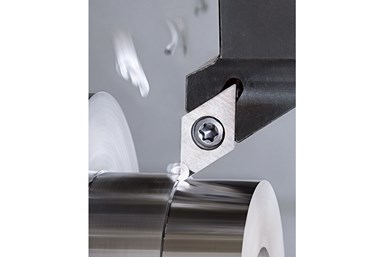Tungaloy’s PCD Turning Inserts for Improved Chip Control
The inserts feature an all-purpose NS chipbreaker for nonferrous applications.

Tungaloy PCD turning insert. Photo Credit: Tungaloy
Tungaloy’s PCD turning inserts now feature a 3D NS chipbreaker which is designed to provide chip control in nonferrous applications for improved productivity.
The inserts were developed to address the issue of long, continuous chips which are generated during the machining of aluminum or copper alloy parts with a conventional PCD insert that has no integrated chipbreaking geometry. These long chips can often cause scratching of the machined surface which can diminish productivity and the resulting surface quality.
The 3D chipbreaker is directly engraved on the PCD tip. This enables the generation of short chips during the machining of gummy metals (such as aluminum and copper alloys), thereby significantly reducing machine downtime due to chip associated troubles.
The chipbreaker is designed to cater to a wide cutting depth range — from extremely light up to 2.0-mm (0.079") DOC. This enables a single PCD insert to handle a variety of operations, from roughing to finishing, giving users the benefit of integrating machining processes and reducing insert inventory for improved productivity.
There are 10 new PCD inserts featuring the chipbreaker in the DX110 grade, providing the insert with a secure edge line for a high-quality, mirror-like surface finish, the company says.
Related Content
-
Increased Competition Calls for Smarter Solutions
Engineered for efficiency, SW Machines offers customers a full suite of horizontal machining centers and the automation needed for high-volume, high-precision manufacturing.
-
Data Matrix Codes Offer Cutting Tool Traceability
A company’s quest to discover errors in a manufacturing process has led to printing data matrix codes on its cutting tools that provide a wealth of information for both the user and this cutting tool manufacturer.
-
Parting Off: The Case for Standardizing on Sawing
The value of rotary saw cutting for parting off operations could boil down to simple economics paired with process efficiency gains.















